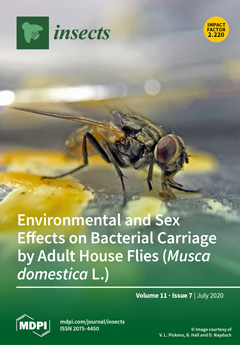Until recently, the Old World bollworm (OWB)
Helicoverpa armigera (Hübner) and the corn earworm
Helicoverpa zea (Boddie) (Lepidoptera: Noctuidae) were geographically isolated. Both species are major pests of agricultural commodities that are known to develop insecticide resistance, and they now coexist in areas
[...] Read more.
Until recently, the Old World bollworm (OWB)
Helicoverpa armigera (Hübner) and the corn earworm
Helicoverpa zea (Boddie) (Lepidoptera: Noctuidae) were geographically isolated. Both species are major pests of agricultural commodities that are known to develop insecticide resistance, and they now coexist in areas where
H. armigera invaded the Americas. This is the first study to compare the susceptibility of the two species to conventional insecticides. The susceptibility of third instar
H. armigera and
H. zea larvae to indoxacarb, methomyl, spinetoram, and spinosad was determined using a diet-overlay bioassay in a quarantine laboratory in Puerto Rico. Mortality was assessed at 48 h after exposure for up to eight concentrations per insecticide. Spinetoram exhibited the highest acute toxicity against
H. armigera, with a median lethal concentration (LC
50) of 0.11 µg a.i./cm
2, followed by indoxacarb and spinosad (0.17 µg a.i./cm
2 for both) and methomyl (0.32 µg a.i./cm
2). Spinetoram was also the most toxic to
H. zea (LC
50 of 0.08 µg a.i./cm
2), followed by spinosad (0.17 µg a.i./cm
2) and methomyl (0.18 µg a.i./cm
2). Indoxacarb was the least toxic to
H.
zea, with an LC
50 of 0.21 µg a.i./cm
2. These findings could serve as a comparative reference for monitoring the susceptibility of
H. armigera and
H. zea to indoxacarb, methomyl, spinetoram, and spinosad in Puerto Rico, and may facilitate the detection of field-selected resistance for these two species and their potential hybrids in areas recently invaded by
H. armigera.
Full article






